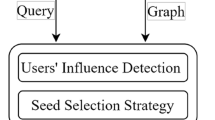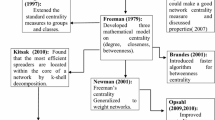Abstract
Rapid growth and development of social networks has attracted the interest of the scientific community to utilize these huge datasets for research purpose. However, preserving the privacy of the users in the published data has also become an important concern. An adversary with very little background knowledge about the actors can extract personal information from the published data. To prevent such type of attacks, different anonymization models have been proposed for relational micro-data, which are further extended and adjusted to handle social network data. Preserving the structural properties of the raw graph is one of the most important aspects of social network anonymization. In this paper, we propose an (α, k) anonymity model based on the eigenvector centrality of the nodes present in the raw graph. We further extend the (α, k) anonymity model to propose (α, l) diversity model and (α, c, l) diversity model, which can also protect the sensitive attribute values associated with a particular actor. For anonymization purpose, we applied the noise node addition technique to generate the anonymized graphs. We tested our proposed algorithms with both synthetic dataset and real dataset. The results obtained show the effectiveness of our proposed algorithm in preserving the structural property of the raw graph. Our proposed methods add noise nodes efficiently so that they have minimal social importance.










Similar content being viewed by others
References
Bhagat S, Cormode G, Krishnamurthy B, Srivastava D (2009) Class-based graph anonymization for social network data. Proc VLDB Endow 2(1):766–777
Bonacich P (1972) Factoring and weighting approaches to clique identification. J Math Soc 2:113–120
Bonacich P (2007) Some unique properties of eigenvector centrality. Soc Netw 29:555–564
Campan A, Truta TM (2008) A clustering approach for data and structural anonymity in social networks proceedings of the second ACM SIGKDD international workshop on privacy, security, and trust in KDD (PinKDD’08)
Campan A, Truta TM, Cooper N (2010) P-sensitive k-anonymity with generalization constraints. Trans Data Priv 2:65–89
Chakraborty S, Tripathy BK (2015) Privacy preservation in social networks through alpha–anonymization techniques. In: Proceedings of the 2015 IEEE/ACM international conference on advances in social networks analysis and mining (ASONAM 2015), pp 1063–1064
Cheng J, Fu AWC, Liu J (2010) k-isomorphism: privacy preserving network publication against structural attacks. In: Proceedings international conference management of data, pp 459–470
Cormode G, Srivastava D, Yu T, Zhang Q (2008) Anonymizing bipartite graph data using safe groupings. Proc VLDB Endow 1(1):833–844
Frikken KB, Golle P (2006) Private social network analysis: how to assemble pieces of a graph privately. In: Proceedings of the fifth ACM workshop privacy in electronic Society (WPES’06), pp 89–98
Hay M, Miklau G, Jensen D, Towsley D, Weis D (2008) Resisting structural re-identification in anonymized social networks. Proc VLDB Endow 1:102–114
Li N, Li T (2007) T-closeness: privacy beyond k-anonymity and l-diversity. In: Proceedings of the IEEE 23rd international conference data engineering (ICDE’07), pp 106–115
Liu k, Terzi E (2008) Towards identity anonymization on graphs. In: Proceedings of the ACM SIGMOD international conference management of data (SIGMOD’08), pp 93–106
Machanavajjhala A, Kifer D, Gehrke J, Venkitasubramaniam M (2007) l-Diversity: privacy beyond k-anonymity. ACM Trans Knowl Discov Data 1:3
Narayanan A, Shmatikov V (2009) De-anonymizing social networks. In: Proceedings of the IEEE 30th symposium on security and privacy, pp 173–187
Newman ME (2006) Finding community structure in networks using the eigenvectors of matrices. Phys Rev E 74(3): 036104
Shrivastava N, Majumder A, Rastogi R (2008) Mining (social) network graphs to detect random link attacks. In: Proceedings of the IEEE 24th international conference on data engineering (ICDE’08), pp 486–495
Sweeney L (2002) k-Anonymity: a model for protecting privacy. Int J Uncertain Fuzziness Knowl Based Syst 10:557–570
Wong RC, Li J, Fu AW, Wang K (2006) (α, k)-anonymity: an enhanced k-anonymity model for privacy preserving data publishing, Proceedings of the ACM SIGKDD, pp 754–759
Ying X, Wu X (2008) Randomizing social networks: a spectrum preserving approach. In: Proceedings of the eighth SIAM conference data mining (SDM’08)
Yuan M, Chen L, Yu PS, Yu T (2013) Protecting sensitive labels in social network data anonymization. IEEE Trans Knowl Data Eng 25(3):633–647
Zheleva E, Getoor L (2007) Preserving the privacy of sensitive relationships in graph data. In: Proceedings of the first SIGKDD international workshop privacy, security, and trust in KDD (PinKDD’07), pp 153–171
Zheleva E, Getoor L (2009) To join or not to join: the illusion of privacy in social networks with mixed public and private user profiles. In: Proceedings of the 18th international conference World Wide Web (WWW’09), pp 531–540
Zhou B, Pei J (2008) Preserving privacy in social networks against neighborhood attacks. In: Proceedings of the IEEE 24th international conference data engineering (ICDE’08), pp 506–515
Zhou B, Pei J (2011) The k-anonymity and l-diversity approaches for privacy preservation in social networks against neighborhood attacks. Knowl Inf Syst 28:47–77
Author information
Authors and Affiliations
Corresponding author
Rights and permissions
About this article
Cite this article
Chakraborty, S., Tripathy, B.K. Alpha-anonymization techniques for privacy preservation in social networks. Soc. Netw. Anal. Min. 6, 29 (2016). https://doi.org/10.1007/s13278-016-0337-x
Received:
Revised:
Accepted:
Published:
DOI: https://doi.org/10.1007/s13278-016-0337-x




